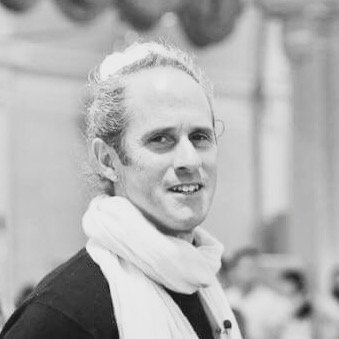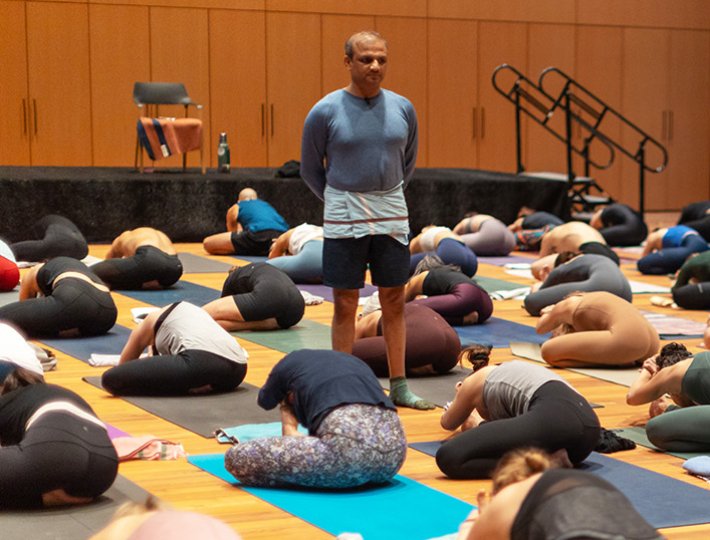The Aṣṭāṅga yoga method of Sri K. Pattabhi Jois is well known for its ‘Mysore method’ of teaching, named for the city in South India in which Jois lived and taught for over 70 years. It is a traditional way to teach students individually but in a group environment. This differs from the standard led (guided) classes that are now common to most forms of yoga.
In ‘Mysore class’, students work at their own pace, practicing whatever series or section of a series that is appropriate for their individual needs and ability. The class is mostly silent apart from a few words of instruction, with only the combined sound of breathing in the room as a backdrop. It requires a skilled and experienced teacher able to give individual attention as and when each practitioner requires and with as little interruption as possible to the continuity of their inner flow of experience.
This method is particularly powerful when a student dedicates themselves to a single teacher. The nourishing of a close student-teacher relationship allows the teacher to understand the idiosyncrasies of each student, and gain an insight into how to help their progression both in the short and longer term.
At one level the teacher’s role is to make sure that each student is practicing correctly, including their breathing, vinyāsa, alignment in each posture, dṛṣti, etc. However, the Mysore method allows the teacher to give students enough space to explore and experience the yogic process internally, without unnecessary interference. They should guide them toward self-discovery, rather than trying to define their experience. Much of the time the teacher’s role is simply to provide a supportive environment for the yoga to evolve while observing their practice, making corrections only when necessary.
In modern culture, we are used to paying for services and expecting a tangible return. In yoga, what is being taught is often very subtle and unfolds slowly over time. When a student has an attitude or expectation of paying for service, there is less of an opportunity for self-discovery and the process of yoga is less likely to take place. Mysore teachers must therefore educate students in the philosophy and methodology of Aṣṭāṅga yoga so that students will fully embrace the opportunity for supported self-learning to get the most out of their practice.
In the Mysore room, there exists the opportunity for complete silence. Often only a few words may need to be exchanged between a student and their teacher throughout the whole class. For some, particularly those who are used to being guided, the silence can be confronting. But just as silence in a library allows you to become immersed in the subject that you’re reading, silence in the Mysore room supports a focused and attentive practice.
Related: The Meditative Magic of Tristhāna in Ashtanga Yoga
I occasionally hear from a new student that they have come to yoga class in order to ‘switch off’, preferring to just follow along in a guided environment. Patañjali defines yoga as the ability to maintain stable and unwavering attention, thus ‘switching off’ is somewhat antithetical to yoga. Conversely, self-practice requires the development of greater focus and attention, and over time the result is a calmer and less scattered mind, resulting in the liberation of more energy. The memorization and self-direction inherent in the Mysore method are important in this process.
Breath is key, and it is essential to learn and develop the specific breathing technique required in Aṣṭāṅga yoga. Since the breathing of each student will differ in terms of capacity and quality, students need to be able to work on this independently. The Mysore method allows students to be taught slowly so that they can fine-tune the breathing for each new āsana and vinyāsa without forming bad habits that need to be undone later.
The consistency of the breath should be smooth and even, with inhales and exhales of the same duration. It should remain constant throughout all of the different āsanas and vinyāsa movements, from the first Sūryanamaskāra until laying down for rest at the end of practice. Attention should be focused on the initiation, movement, and completion of each breath; its synchronization with each vinyāsa; and with the internal form of the āsana. Breathing is also connected to the steadiness of the dṛṣṭi (gazing point). When all these elements are in tune with the breathing, āsana practice becomes a form of dhyāna or meditation.
It is important to understand some philosophy in order to inform the qualities of practice that lead you toward a yogic state of clear and stable attention. An obsession with outward form can lead to injury as a result of not listening internally, but it can also lead you away from the very of essence of where yoga seeks to take you.
In his Yoga Sutras, Patañjali says that āsana should have the dual qualities of sthira (stability) and sukha (comfort or ease). He does not describe any specific āsana, and many classical commentaries describe that āsana refers only to a comfortable seated posture for the purpose of meditation.
The sanskrit root of the word āsana, √ās, has the meaning to ‘sit or sit down’, but it also has the extended meanings ‘to be present, to sit quietly, to abide, to remain, or to continue’. One interpretation of this sutra is that the word āsana infers the embodiment of a particular state, rather than a particular posture. We should therefore aim to embody a ‘state’ of comfort and steadiness in our posture, breath, dṛṣṭi. and attention. You can apply this ‘state’ of āsana to all aspects of life. Practicing the Mysore method supports this aim, asking us to listen internally and cultivate stability and comfort that can be applied in every aspect of our spiritual practice and, indeed, every aspect of life.
Related: A Master’s Take on Why Yoga Is for Everyone
In Aṣṭāṅga yoga, the tradition has developed to finish each week with a led primary series class. This is an opportunity for each student to practice the correct vinyāsa and breathing while following the strict count of the teacher. It can be quite challenging to do, especially during more difficult āsanas and vinyāsas, and it is an opportunity to gauge where we are in our practice and to see how the mind and senses react. The once weekly led class provides a perfect balance to daily Mysore self-practice during the week, and together they are an extremely beneficial combination.
I recommend that anybody who is able to practice with Paramaguru Sharath Jois. If you cannot make the pilgrimage to the KPJAYI school in Mysore in India, try to attend his classes when he is on tour. He has experienced yoga very deeply through his own sādhana, from many years spent in the continuous presence of his grandfather and guru, and by teaching thousands of students over many decades. The result is a great depth of wisdom and understanding but with a very simple and accessible approach to teaching.












Comments (0)